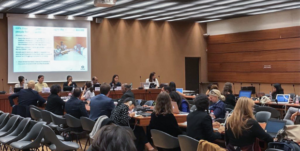At JIPS, we strongly believe that communities should be included in key stages of a profiling data cycle to ensure that the process reflects their realities and priorities. The centrality of IDP participation, outlined in the Guiding Principles on Internal Displacement, has recently been re-affirmed during a panel discussion on the human rights of IDPs at the 38th Session of the Human Rights Council (HRC), held in Geneva in June 2018.
In order to help strengthen the link between community engagement and profiling, we took part in a recent HRC side event focused on the connection between participation of IDPs and securing solutions to their displacement. Co-hosted by Austria, Uganda, and Honduras and moderated by Ms. Cecilia Jimenez-Damary, Special Rapporteur on the human rights of IDPs, the event featured interventions from Muhsin Siddiquey, Country Director at Oxfam Yemen, Valerie Svobodova, Senior Donor Relations Officer (Inter-agency) at UNHCR, Torill Sæterøy, NRC’s Senior Regional Advisor for Latin America, and our colleague Dr. Isis Nunez Ferrera, Urban Profiling Advisor.
By providing concrete examples from profiling exercises recently supported, Dr. Isis Nunez Ferrera stressed the added value of community engagement, both from a data quality viewpoint and the perspectives of affected populations.

HRC side event on IDP participation (Nov 2018).
In line with our commitment to advance community engagement, we have been investing a lot of time and effort in engaging IDPs and displacement-affected communities in profiling processes. The experience gained has shown that this approach strongly impacts the value and quality of data collected, and also contributes to the awareness raising and empowerment of communities involved.
In her intervention, Isis Nunez Ferrera briefly delineated the reasons why it is crucial to invest in community engagement: to make sure displaced and displacement-affected communities are able to make informed decisions, express their preferences and actively contribute to the evidence-base and the analysis that informs durable solutions. Highlighting the importance of professional standards, she strongly reaffirmed the need to treat participatory approaches with the same type of rigor with which we treat other types of assessment. This includes tailoring data collection tools to the context and to the specific population groups, as well as adequate mechanisms to capture, process and disseminate the data collected in a format that is useful to the communities as users.
In order to successfully implement community engagement in a profiling process, we need to understand it as a process rather than only a goal in itself. It can include different types of participatory approaches ranging from low-level engagement methods, such as consultation, to high-level ones, such as collaboration. The decision on which one to utilise will need to be tailored to the population, to the context, and to the different stages of the profiling process. Examples include:
Disseminating profiling findings with communities in Sittwe, Myanmar: IDPs were engaged in discussions on the relevance of community participation in the data process. Idea generation workshops were held with IDPs to brainstorm on the best feedback channels and methods, taking account of low literacy levels and IDPs’ inability to understand or engage with printed materials and complex data products. To this end, alternative methods for dissemination and validation of results (such as role-play, videos and quizzes, and feedback through phone recordings) were adopted.
Interventions by colleagues from Oxfam, UNHCR and NRC, focused on experiences of community engagement in Niger, Yemen and Honduras, clearly showed how community engagement can be implemented even in extremely dynamic contexts, as well as during ongoing humanitarian crises. In Yemen, for example, IDPs (women in particular) have been involved in needs assessment processes and consultations on the peace process and peace building at community level. Muhsin Siddiquey from Oxfam Yemen strongly advocated for support from national and international actors to women’s preparation, design and participation in donor conferences, in order to ensure interventions appropriately target the needs of IDPs and host communities.
In Honduras, as recalled by Torill Sæterøy from NRC, IDPs were involved in the discussion on durable solutions and, significantly, consulted in regard to the drafting of the IDP law. The final version of the law is currently being prepared, and will hopefully reflect IDPs recommendations and soon be passed and implemented in the country.
Some additional, interesting thoughts and recommendations emerged from the session and the Q&A time that followed. These included:
In conclusion, what substantially emerged from the discussion, it is how crucial the participation of IDPs is in progressing towards durable solutions to internal displacement. As also mentioned in the GP20 Plan of Action, it is important to engage in a dialogue with national governments and IDPs to ensure that they prioritize durable solutions to internal displacement in their national and regional planning.